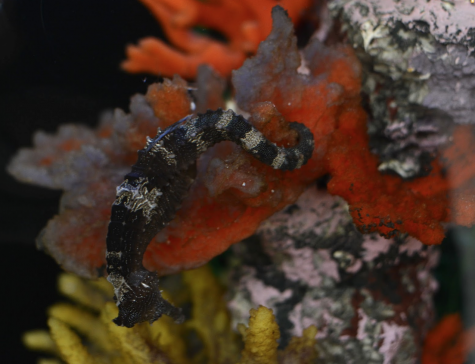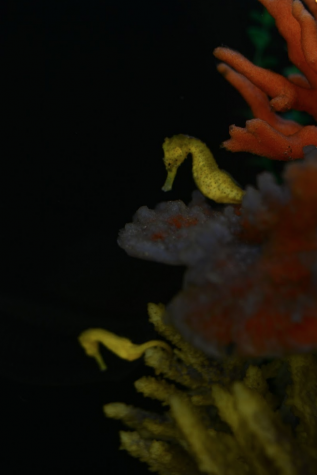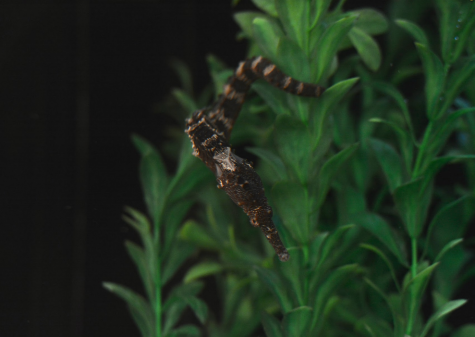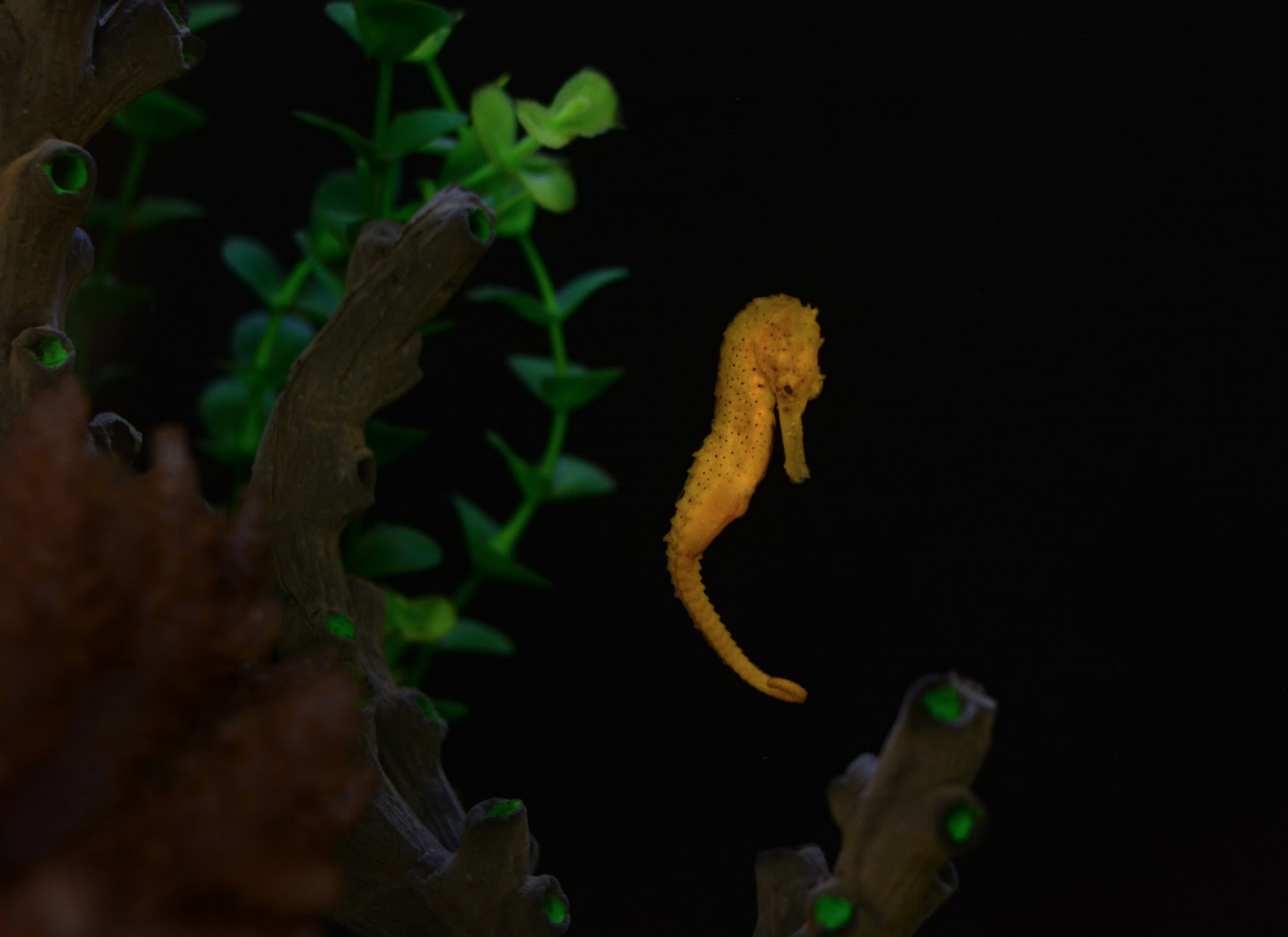Seahorse tank emphasizes importance of conservation
May 2, 2019
With their mottled tails curled around a vibrant green and yellow sea fan, two 3-inch seahorses with beige speckles peek out from behind the veins of artificial coral. The newest additions to the tank have clearly made themselves quite comfortable, with their journey to the atrium of Nichols first starting at a breeding center in Los Angeles.
After Science Department Chair Anita Chetty received a call from the owner of Sea Life Aquarium Maintenance, Jeff Jacinto, who had been taking care of the adjacent saltwater reef aquarium for the past eight years, he informed her that a client who was moving overseas had ordered a seahorse tank and would no longer be able to use it, which opened up an opportunity for the school. She accepted.
“He services over close to one hundred tanks in the Bay Area, and we are the only ones with seahorses,” Chetty said. “It’s very rare to keep seahorses in a tank.”

One of the seahorses curls its tail around a piece of artificial coral. They were brought to Nichols from a seahorse breeder in Los Angeles.
Since seahorses are extremely sensitive to pH, the level of alkalinity or acidity in the water, Jacinto began preparation by laying the bottom of the aquarium with a layer of sand and later added in artificial coral and plants. Seahorses, which are scientifically called hippocampus, are one of the only fish with prehensile tails, allowing them to latch onto plants and restricting their ability to swim to mostly vertical movement due to shortened fins.
“Typically, the furthest north [all seahorses] get is up into San Diego Bay,” upper school biology teacher Dr. Thomas Artiss said. “It comes in a variety of colors that match the surrounding habitat, and it has a prehensile tail, but it lacks a caudal fin, which is the tail fin.”
Currently, the tank contains three dark gray lined seahorses and two smaller yellow kuda seahorses, one of which has slowly changed to a darker color along its spine. Since all the corals and fish are bred in captivity, meaning they have not been taken from the wild, the different types of species that can be obtained are limited.

Both yellow seahorses peek out from behind coral. Everything in the seahorse tank is artificial, since they are extremely sensitive to the pH, or alkalinity and acidity, of the water.
“Nothing has been captured in the wild; that’s very important to us,” Chetty said. “So for the seahorses, for example, those are the two most predominant ones, and we’ve been trying to get more colorful ones in, but it’s very hard to find them.”
The practice of obtaining seahorses from a breeder rather than from the wild is a large step towards conservation. Raising male and female seahorses in captivity allows them to form bonds before mating, which is extremely crucial since they generally pair for life. In order to maintain this bond, it takes extreme precision to make sure that they are cared for properly, which was a major concern in the decision to have seahorses in Nichols.
“They also are sought after in aquaria, and are often taken from the wild rather than from a breeder,” upper school biology teacher Dr. Kate Schafer said. “There are often really, really tight bonds between male and female seahorses, and creating the right conditions in the aquaria for them to develop those bonds could be challenging depending on the species.”
In terms of maintenance, Jacinto personally visits both saltwater tanks on Tuesday and Friday mornings to clean the tank, and teachers from the science department and senior Raymond Banke operate on the rest of the weekdays.
Since seahorses do not have teeth and instead feed by sucking in food through their snouts, they are given two cubes frozen mysis shrimp, crustaceans small enough to fit through that gap. If all goes well, the mysis dissolves into individual pieces and scatters throughout the tank. However, sometimes incidents occur when the seahorses swim too far up to the filter.
“I did have a fiasco recently when one of the seahorses would get caught in the filter intake, so that wasn’t good, but we fixed that problem,” Raymond said. “I would have to let them curl around my finger and have to move them away from the filter intake, which was interesting. I might identify them for medical purposes, like this one has a tail laceration, but they’re all pretty cool.”
Even though the idea of naming the seahorses was initially brought up, they would be difficult to distinguish because of their similar species and markings.

A lined seahorses curls around a piece of artificial vegetation. The farthest north that most species travel is around San Diego.
“The two yellow ones, for example, there’s one that’s smaller than the other, so if we named them, we would know which was which, but the other ones all look very similar, so it would be very hard to identify,” Chetty said.
Instead, she focused on the ultimate goal for the installation of the seahorse tank: to educate students about the threats that seahorses face in the wild due to pollutants and other factors, including being captured as an ingredient in traditional Chinese medicine, with the hope that they can come to understand the unique opportunity to view exotic animals.
“The reason why I was excited to bring in seahorses was because for both of our saltwater systems, we’re planning to get students to appreciate the complexity and beauty of these organisms,” Chetty said. “What we’re trying to do is to get you to observe organisms in as natural of a behavior as you’re going to see in a tank, but for you to understand and appreciate organisms that are threatened in the ocean.”
Correction: May 18, 2019.
“Caudle fin” was corrected to its proper spelling, “caudal fin.”
